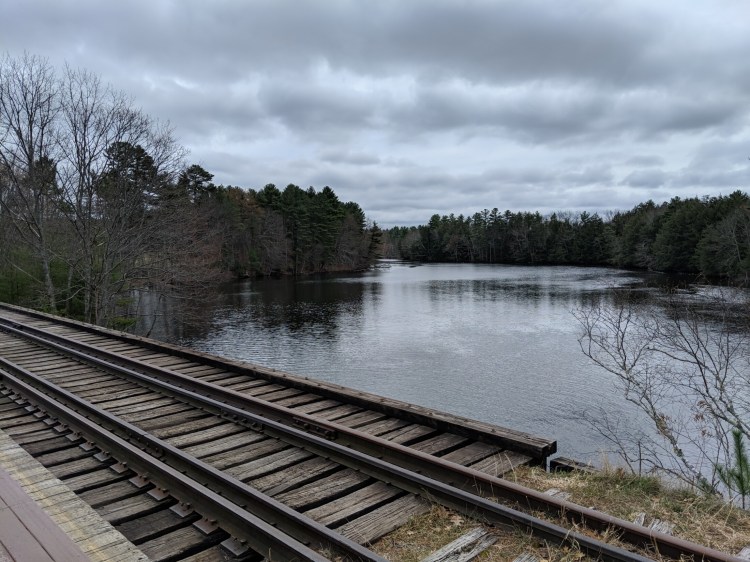Business support is growing for a combined commuter rail line and multiuse trail linking downtown Westbrook to Portland’s waterfront.
Hospitality Maine, the state’s lodging and restaurant trade group, recently became one of the newest members of Portland West Rail and Trail Alliance, a collection of businesses and nonprofits that support the concept.
“Portland has created a world-class restaurant and lodging industry, supporting a vibrant, young hospitality workforce,” said Hospitality Maine CEO Steve Hewins in a statement. “For our success to continue, we need an equally vibrant transportation system. Limited parking, traffic congestion, a shortage of downtown housing are all factors that could derail Portland’s still growing hospitality industry.”
The loosely organized alliance was established following a July report on the possibility of creating a light rail line along an existing rail corridor between Portland and Westbrook. Its 15 members include prominent companies such as Bernstein Shur law firm, National Distributors beer and wine wholesalers, People’s United Bank, clothing manufacturer American Roots and groups like Live and Work in Maine and Presumpscot Regional Land Trust.
Dreams of a commuter rail tap into growing demand from businesses, government and commuters for more mass transit options in the Portland area. Expanded public transit was the number one priority for respondents to a recent transportation survey from Greater Portland Council of Governments. Metro, the area public bus service, has increased ridership and added new routes in the last four years and the Amtrak Downeaster is considering schedules to accommodate local commuters.
Considering the unfunded $100 million cost, a 6-mile passenger rail connecting Main Street in Westbrook to Commercial Street in Portland may not be a cost-effective means of mass transit, but the idea has caught people’s imagination. The envisioned line would stop at the Portland Transportation Center and Rock Row, a commercial and housing complex under development in Westbrook. According to a concept report, more than 2,100 passengers could ride the train daily at full build-out.
In addition, the rail line could be paired with a paved multi-use path parallel to the train tracks and within the railroad right of way. The trail project could cost $5.2 million, according to a feasibility report.
Adria Horn, vice president of workforce at alliance member Tilson Technology in Portland, said a commuter rail that would allow employees to park outside the city center and take a train in is appealing, but any alternative is welcome. The company is looking for ways to get a handle on the lack of adequate parking for the 181 employees at its Middle Street offices.
“It helps us as a company and creates expectation management for how employees can get to work in an convenient and reliable manner,” Horn said.
For Tim Longstaff, president of National Distributors, a regional commuter rail is more about making sure local businesses thrive than alleviating his own company’s mobility problems. The beer and wine distributor has its headquarters and main warehouse in South Portland.
“It sounds like a good idea to ease the parking pressure on the Old Port,” Longstaff said. “Anything that can help make it a desirable place for people to go and support local businesses, I’m all for that.”
A multi-use trail next to the railroad could give people another option to travel between Portland and Westbrook, said Rachelle Curran Apse, executive director of the Presumpscot Regional Land Trust.
Trails alongside railroads in Vermont, Pennsylvania and Quebec have attracted tourists as well as being commuter thoroughfares, Apse added. Developing the corridor could add to the Portland region’s destination appeal.
“As a land trust, our role is to connect people to the outdoors; this is one of the most popular ways to get people outside and enjoying nature,” she said. “We see an active rail next to a trail as something really common in the rest of the country and something that is really possible here,” she added.
While members of the alliance have signaled their support for the concept, none have signed on to provide financial support at this point. No funding sources were identified in the July report, and there is no working plan to build a commuter rail.
But it is encouraging that people are genuinely interested in talking about ways to remedy traffic congestion by getting more cars off the roads in the Portland area, said Tory Ryden, a public relations consultant working on the project. Passenger rail is expensive and may not be the panacea to regional mobility issues, but it may be part of the remedy with public buses, car pooling and ride sharing and taxis, she added.
“It is going to take a big group of thinkers to consider what it is going to take to get however many cars off the road,” Ryden said. “Let’s find a solution here; if we don’t do it now we are going to be so far behind the 8-ball.”
Send questions/comments to the editors.




Comments are no longer available on this story